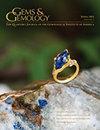Big Sky Country Sapphire: Visiting Montana's Alluvial Deposits
IF 1.6
3区 地球科学
Q2 MINERALOGY
引用次数: 2
Abstract
S has been mined in the western U.S. state of Montana for more than a century and a half. Historically, gem-quality sapphires have been mined commercially in four main areas in southwestern Montana, shown in figure 1: the upper Missouri River gravel bars (1865), Dry Cottonwood Creek (1889), Rock Creek (1892), and Yogo Gulch (1895). Today, the first two areas remain quite active, while operations in Yogo Gulch and Dry Cottonwood Creek have been suspended for many years. To better understand the characteristics of Montana sapphire and record current mining and commercial activities, GIA sent a team to visit the placer deposits at the upper Missouri River and Rock Creek areas in August 2015. Since the latter half of the 19th century, Montana’s history has been intertwined with gold, silver, and copper mining. Corundum was discovered during the course of gold mining activities in southwestern Montana. Before the 1940s, the state’s alluvial sapphire deposits were exploited mainly to supply the watch industry, but production fell dramatically with the use of synthetic sapphire in watch bearings (Emmett and Douthit, 1993). Among Montana’s secondary deposits, Rock Creek (figure 2) is the only area mined specifically for sapphire from its discovery in 1892 until World War II (Clabaugh, 1952). While Yogo Gulch is a primary deposit, the placer deposits at Rock Creek, Dry Cottonwood Creek, and the upper Missouri River near Helena have been a matter of speculation among researchers trying to work out the origin of these sapphire crystals. Research indicates that they were carried to the surface by volcanic activity, but their ultimate origin is still an open question, even after about 125 years of searching (e.g., Pratt, 1906; Clabaugh, 1952; Garland, 2002; Berg and Dahy, 2002; Berg, 2014; Zwaan et al., 2015). Due to the lack of significant sapphire-bearing host rock outcrops in these areas, the search and discussion continue. The glamour of the sapphires, the mysteries of their origin, the area’s mining history, and the natural beauty of Big Sky country are an intriguing combination (figure 3).Big Sky Country Sapphire:参观蒙大拿州的冲积矿床
S在美国西部的蒙大拿州已经开采了一个半世纪。从历史上看,宝石级蓝宝石在蒙大拿州西南部的四个主要地区进行了商业开采,如图1所示:密苏里河上游的砾石坝(1865年)、干科顿伍德溪(1889年)、岩石溪(1892年)和Yogo Gulch(1895年)。如今,前两个地区仍然相当活跃,而Yogo Gulch和Dry Cottonwood Creek的运营已暂停多年。为了更好地了解蒙大拿蓝宝石的特征并记录当前的采矿和商业活动,GIA于2015年8月派出一个团队参观了密苏里河上游和Rock Creek地区的砂矿。自19世纪后半叶以来,蒙大拿州的历史一直与黄金、白银和铜矿开采交织在一起。刚玉是在蒙大拿州西南部的金矿活动过程中发现的。在20世纪40年代之前,该州的冲积蓝宝石矿床主要用于供应手表行业,但由于在手表轴承中使用合成蓝宝石,产量急剧下降(Emmett和Douthit,1993)。在蒙大拿州的次生矿床中,Rock Creek(图2)是从1892年发现蓝宝石到第二次世界大战期间唯一专门开采蓝宝石的地区(Clabaugh,1952)。虽然Yogo Gulch是一个主要矿床,但在试图弄清这些蓝宝石晶体起源的研究人员中,Rock Creek、Dry Cottonwood Creek和Helena附近密苏里河上游的砂矿矿床一直是一个猜测问题。研究表明,它们是由火山活动带到地表的,但即使经过大约125年的寻找,它们的最终起源仍然是一个悬而未决的问题(例如,Pratt,1906;Clabaugh,1952;Garland,2002;Berg和Dahy,2002;伯格,2014;Zwaan等人,2015)。由于这些地区缺乏重要的含蓝宝石的主岩露头,搜索和讨论仍在继续。蓝宝石的魅力、其起源的奥秘、该地区的采矿历史以及大天空国家的自然美景是一个有趣的组合(图3)。
本文章由计算机程序翻译,如有差异,请以英文原文为准。
求助全文
约1分钟内获得全文
求助全文
来源期刊

Gems & Gemology
地学-矿物学
CiteScore
2.90
自引率
19.20%
发文量
10
期刊介绍:
G&G publishes original articles on gem materials and research in gemology and related fields. Manuscript topics include, but are not limited to:
Laboratory or field research;
Comprehensive reviews of important topics in the field;
Synthetics, imitations, and treatments;
Trade issues;
Recent discoveries or developments in gemology and related fields (e.g., new instruments or identification techniques, gem minerals for the collector, and lapidary techniques);
Descriptions of notable gem materials and localities;
Jewelry manufacturing arts, historical jewelry, and museum exhibits.
 求助内容:
求助内容: 应助结果提醒方式:
应助结果提醒方式:


